#1 Network Penetration Testing Services (Trusted by 1000+ Teams)
We simulate real-world attacks through expert-led manual network pentesting, backed by certified, tested methodologies. Each test aligns with NIST/ISO frameworks, while risk prioritization and reporting help with faster, informed remediation.

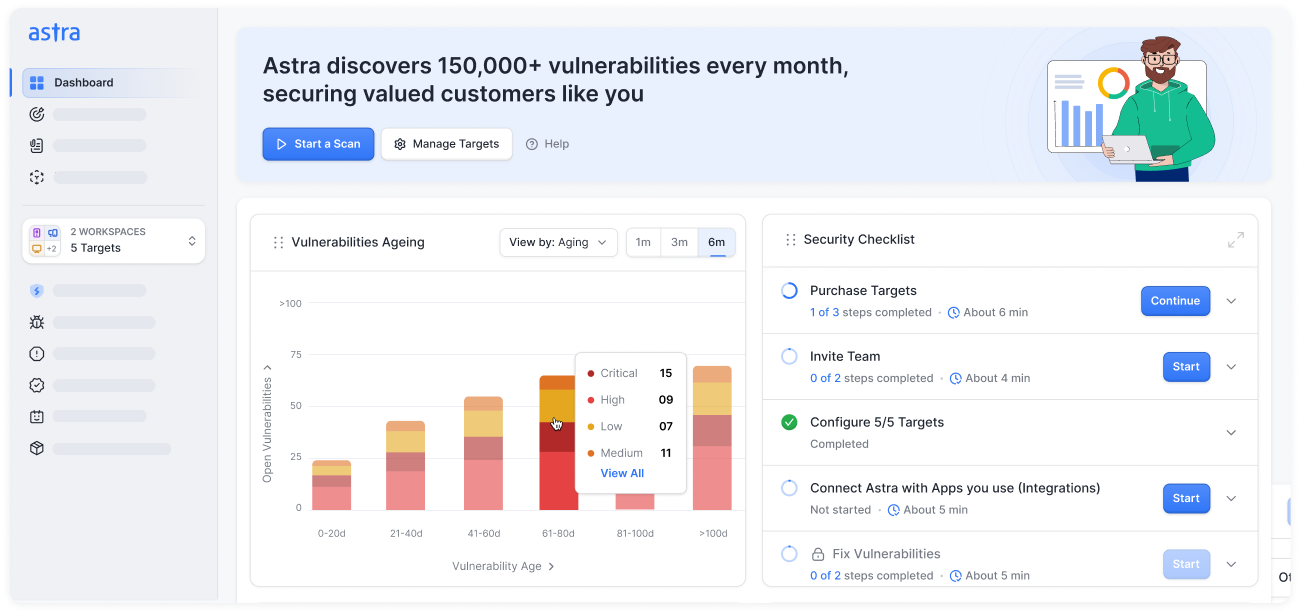










Why choose Astra Security's network penetration testing services?
Experience our audit plans built for contemporary network pentest and engineering teams with expert-driven testing, smart automation, and continuous protection at scale.
- Focus on real vulnerabilities with noise-free detection logic
- Our experts vet false positives so you don’t waste hours validating noise
- Mark verified issues once to skip them in future scans
- Get expert vulnerability reviews for faster prioritization
- Cut manual tuning as our AI-augmented network pentest service adapts tests to your app
- Context-aware analysis improves accuracy & guidance with our AI chatbot & experts
- Use machine learning models to evaluate chained vulnerability impact evolving from real-world exploit data
- Scale testing without increasing security headcount
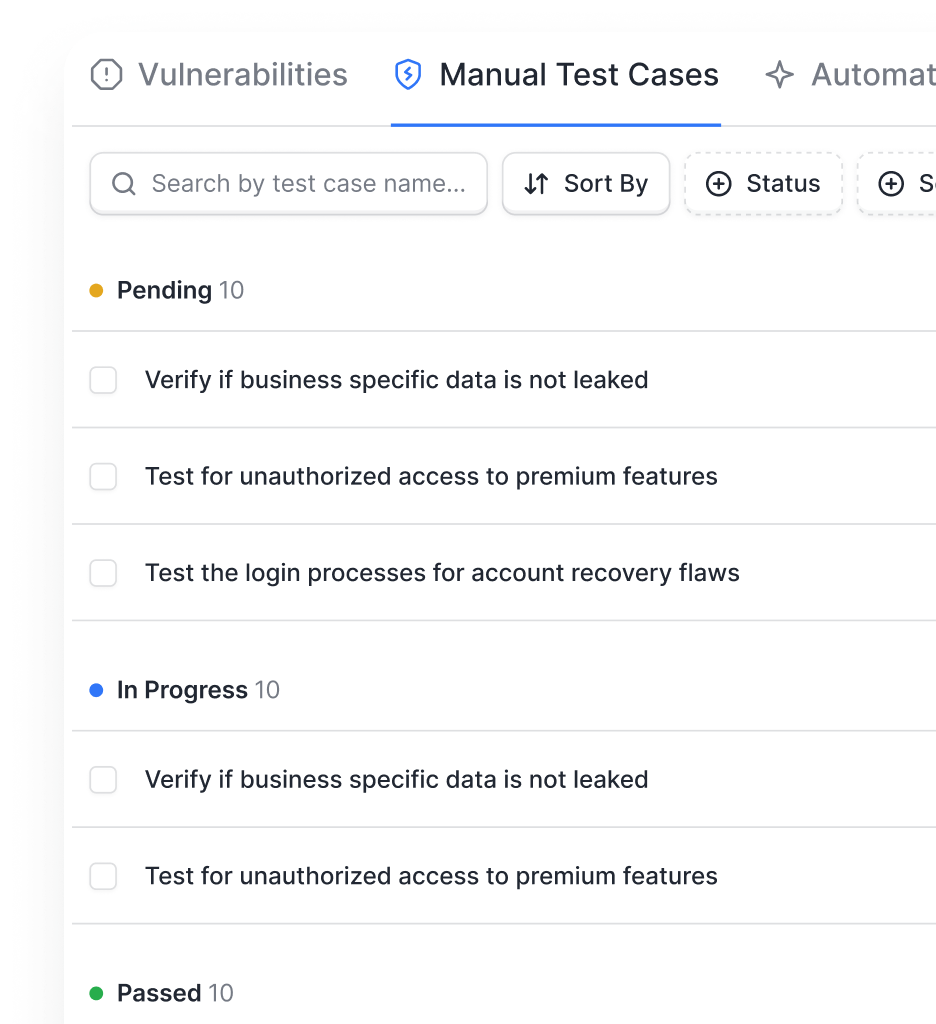
- Get continuous protection across your network infrastructure
- Avoid alert fatigue with business-impact optimized vulnerabilities & expert-tuned pentests
- Stay compliant with solution-first reports, verified fixes, and targeted automated rescans
- Cut false positives and reduce total cost with managed accuracy pentests
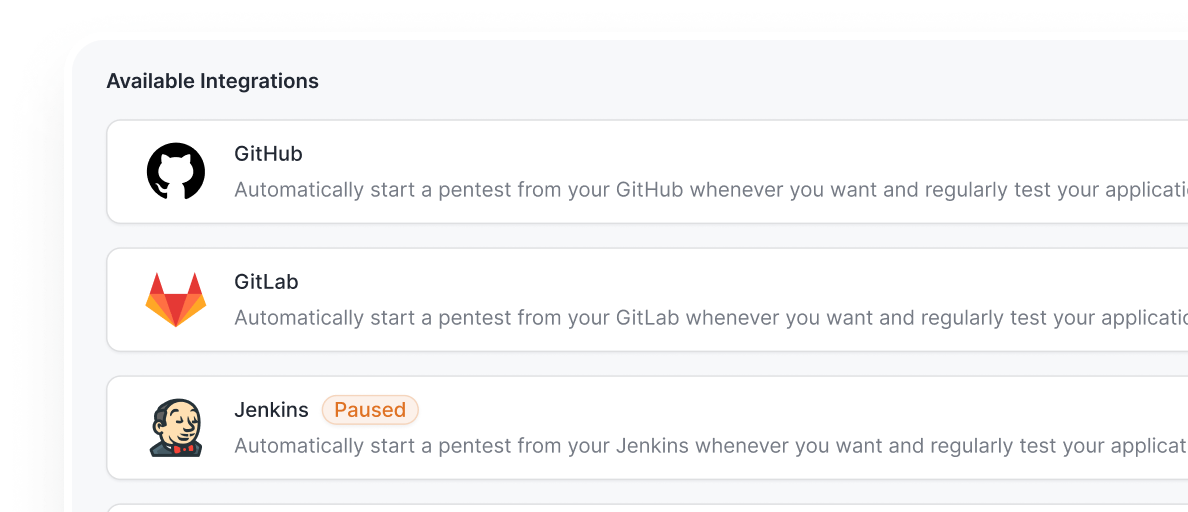
- Integrate testing seamlessly into your CI/CD workflows (GitHub, GitLab, CI, Jenkins, Bitbucket, & more) with zero release delays
- Automate Slack vulnerability alerts and JIRA ticketing to cut manual work
- Shorten your mean time to remediate with seamless vulnerability workflows
- Maintain speed-to-market without compromising security
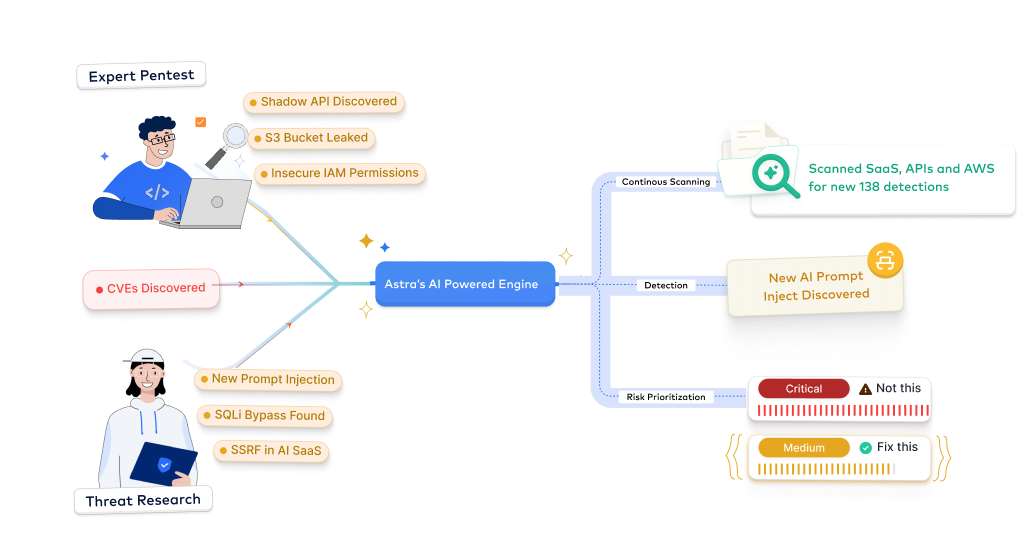
- Generate audit-ready reports for ISO, PCI, SOC 2, HIPAA, GDPR, OWASP, NIST, and more
- Accelerate certification with simplified expert-led guidance
- Demonstrate security maturity to shorten sales cycles
- Turn compliance readiness into a sales advantage

Simulate real-world attacks, uncover hidden risks, and strengthen your defenses with expert-led network penetration testing services starting at $199/IP.
Start TrialAstra's 7-Step Pentest Process
How our network penetration testing services work?
Learn how our team delivers smarter protection through expert-led vulnerability assessments, pentests, and audits.
Discovery & Scoping
- Identify all in-scope network assets, including IP ranges, domains, subdomains, routers, firewalls, and connected devices
- Define environments (production, staging, or test) and parameters to ensure 360° coverage
- Align engagement with compliance frameworks such as PCI, ISO, SOC 2, HIPAA, or custom enterprise requirements
- Personalized setup to maintain visibility throughout the engagement
Outcome: Outline a mutually-agreed compliance-ready scope and a clear roadmap to audit readiness tailored to your business


Authentication & Access Configuration
- Configure secure authentication for internal and privileged network access to test authenticated zones
- Integrate credentials, tokens, and session settings to enable in-depth testing while maintaining operational safety
- Validate network authentication mechanisms (VPNs, firewalls, RADIUS, LDAP/AD authentication, etc.) without disrupting production
Outcome: Full-depth, authenticated testing across internal and external networks with zero disruption to business continuity
Automated Baseline Assessment
- Perform automated vulnerability discovery across the entire network infrastructure
- Detect OWASP Vulnerabilities, critical CVEs, configuration flaws, and business logic vulnerabilities using advanced scanning engines
- Correlate automated findings with prior assessments for historical tracking and continuous improvement
- Deliver monitoring insights supporting compliance and audit preparedness
Outcome: Gain a live, data-backed vulnerability baseline enabling proactive defense and faster remediation


Manual Penetration Testing & Risk Scoring
- Security experts manually exploit identified weaknesses to validate exploit chains, real-world impact, and business relevance
- Create detailed Proof-of-Concepts (PoCs) for high-risk findings and contextual remediation strategies
- Apply CVSS v3 and contextual business risk scoring to prioritize based on impact & compliance exposure
- Deliver technical and executive-level risk summaries for clear decision-making
Outcome: Get an actionable, prioritized threat intelligence aligned with your risk appetite and compliance mandates
Remediation Support
- Deliver detailed, developer-focused remediation steps validated by our expert pentesters
- Provide reproducible PoCs, payloads, and configuration guidance for faster fixes
- Collaborate directly with your engineering team to verify patch effectiveness
- Get documented remediation evidence aligned with audit and compliance requirements
Outcome: Achieve faster, verified fixes supported by our team and documented for full compliance


Re-Scan & Validate
- Conduct targeted re-tests to confirm successful remediation and eliminate residual risks
- Schedule recurring scans to detect regressions after updates or infrastructure changes
- Capture time-stamped validation evidence for audit readiness and certification renewals
- Maintain a verified security baseline that demonstrates continuous improvement over time
Outcome: Secure a certified, publicly verifiable certificate proving continuous security for all stakeholders
From startups to fortune companies,
1000+ companies trust Astra












































.webp)





Experience zero false positives and seamless integrations with Astra’s network penetration testing services.
Request Security ServicesTypes of network penetration testing services
Explore our full suite of network security testing services designed for every layer of your security stack.

Manual Pentesting
- Simulate real-world adversaries with human-led network pentests to validate exploitable gaps across perimeter and internal networks
- Reveal runtime-only flaws (OWASP, CWE, SANS Top 25), chained exploits, insecure protocols, and misconfigurations enabling lateral movement
- Produce PoCs and prioritized remediation tied to exploitability, regulatory exposure, and business impact
- Map findings to PCI DSS, ISO 27001, SOC 2, GDPR, HIPAA, and deliver audit-ready evidence

Workstation pentesting
- Simulate real-world threat actors to analyze the device control environment, processes, and configurations
- Perform security policy and architecture review
- Map vulnerabilities per CIS benchmarks and other compliance standards

Black Box Penetration Testing
- Replicate real-world hacker tactics to evaluate external resilience with zero internal visibility
- Gain insights into exploitable entry points and data exposure risks

White Box Penetration Testing
- Analyze source code, configurations, and logic paths with full internal access
- Detect deep-seated security flaws and vulnerabilities before attackers do

Gray Box Penetration Testing
- Combine external simulation with limited internal access for targeted coverage
- Identify vulnerabilities with higher context and risk relevance
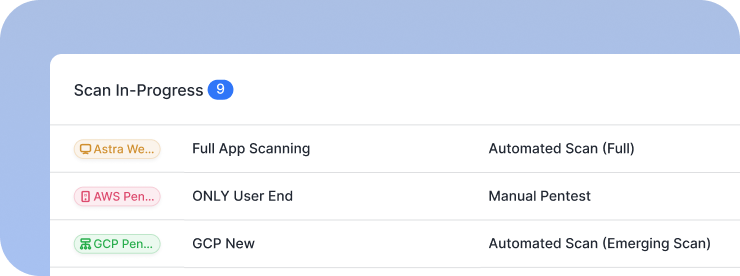
Compliance Penetration Testing
- Test against regional and industry-specific requirements with audit-ready reporting
- Align with global standards to demonstrate regulatory and client trust
- Compliance Mapping: PCI DSS, HIPAA, GDPR, ISO 27001, SOC 2, NIST, CERT-In, CREST, and more





Secure every layer of your network with Astra Security’s expert-led penetration testing for networks.
Book a DemoAstra Security vs traditional vendors
See how our modern approach to network pentesting services outpaces traditional vendor models.
Experience the Astra Security difference: faster, smarter, compliance-ready pentesting.
Pentesting as a service, tailored for your industry
Continuous penetration testing and compliance mapping services built for ISO, SOC 2, HIPAA, PCI DSS, and more.

- Secure financial systems and payment workflows from logic flaws
- Deliver actionable fixes and maintain PCI DSS, ISO 27001, SOC 2, DORA compliance, and more
- Standards: OWASP, PTES, CVSS

- Protect patient data and secure APIs across web, mobile, and cloud
- Uncover hidden PHI exposures and validate HIPAA, ABHA, and more
- Standards: OWASP, PTES, NIST, CVSS

- Accelerate app security with DevSecOps integration and continuous scans
- Detect vulnerabilities with AI-driven validation and ensure ISO 27001, SOC 2, GDPR compliance and more
- Standards: OWASP, PTES, CVSS, NIST SP 800-115

- Protect customer data and secure payment flows from BOLA/IDOR risks
- Empower developers with guided remediation and PCI DSS, ISO 27001, SOC 2 compliance and more
- Standards: OWASP, PTES, CVSS

- Fortify cloud, container, and on-prem systems with authenticated tests
- Monitor and validate vulnerabilities to prevent downtime; comply with NIST, ISO 27001, SOC 2, CREST, Cert-In, and more
- Standards: OWASP, PTES, NIST, CVSS

- Discover shadow APIs and secure cloud services
- Deliver fast, developer-friendly fixes; ensure GDPR, ISO 27001, SOC 2 compliance
- Standards: OWASP, PTES, CVSS
Simulate real-world attacks, uncover hidden risks, and strengthen your defenses with expert-led network penetration testing services starting at $199/IP.
Start TrialOur pentesters? World class, certified & contributors to top security projects
We find the bugs before the bad guys do
Our team stays ahead of the curve in the ever-evolving world of web security

.avif)
.avif)
.avif)




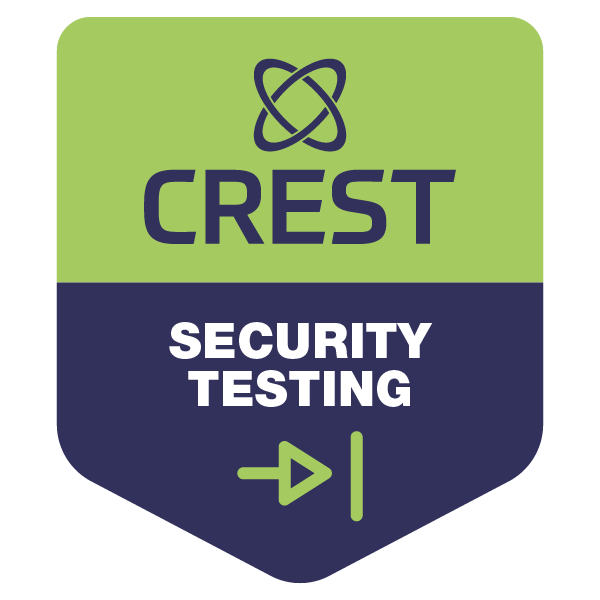
Stay compliant throughout the year
Understand our industry-specific pentests as a service plans designed to meet your compliance, scale, and security needs.
- Get compliance-ready year-round for ISO 27001, SOC 2, GDPR, HIPAA, PCI DSS, CREST, CERT-In, CIS Controls, NIST, & more
- Receive actionable insights from continuous pentesting and expert-led remediation guidance
- Track compliance progress with the Astra Security Compliance View, providing executive-friendly and technical views

- Pentest continuously for new CVEs, OWASP Top 10, SANS Top 25, PTES standards, and more
- Identify and remediate vulnerabilities in real time through automated scans, regression testing, and expert validation
- Monitor your attack surface dynamically with the Astra Security Vulnerability View, showing trends, risk scores, and remediation status

- Maintain audit-ready reports without manual effort
- Reduce risk exposure with real-time detection and validation
- Prioritize remediation based on business impact and compliance requirements
- Demonstrate security maturity to clients, regulators, and internal stakeholders


Frequently asked questions
What are network penetration testing services?
Network penetration testing services simulate real-world cyberattacks to uncover vulnerabilities across internal, external, and wireless networks. Expert-led tests identify misconfigurations, weak access controls, and exploitable flaws in routers, firewalls, and connected devices helping organizations strengthen defenses, validate security controls, and prevent potential data breaches or lateral movement risks.
How does network penetration testing work?
The process begins with discovery and scoping, followed by automated scans and manual exploitation by certified experts. Vulnerabilities are validated, risk-scored, and mapped to compliance standards like PCI DSS, ISO, or NIST, with verified remediation guidance and follow-up rescans to ensure all issues are fixed and documented for audit readiness.
Why is network pen testing important?
Network penetration testing helps organizations uncover weaknesses before attackers do. It prevents data breaches, downtime, and financial losses by validating real-world exploit paths, while regular testing also ensures compliance, strengthens infrastructure security, and enables proactive risk management aligned with evolving threat landscapes and regulatory expectations.
How often should network pen testing be performed?
Network penetration testing should be performed at least once a year or after any major infrastructure change, migration, or incident. Continuous or quarterly testing offers stronger protection, allowing organizations to identify and fix vulnerabilities faster while maintaining compliance and adapting to emerging threats.
How much do network penetration testing services cost?
Network penetration testing services typically range from $5,000 to $40,000, depending on the scope, size, and complexity of the network. Pricing factors include internal vs. external testing, compliance mapping, automation depth, and ongoing monitoring needs, while expert validation ensures maximum accuracy and measurable ROI. Astra Security’s plans start at $199/IP.
Do these tests help meet compliance standards like PCI DSS?
Yes, network penetration tests align with compliance frameworks such as PCI DSS, ISO 27001, SOC 2, HIPAA, GDPR, and NIST. They provide audit-ready reports, verified remediation evidence, and continuous monitoring to help organizations maintain certification and demonstrate robust security practices to regulators and clients.











